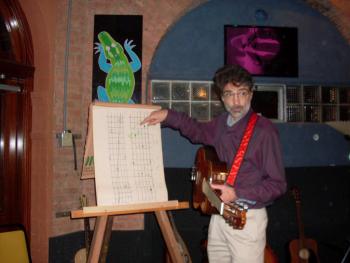Kinloch Nelson & the CAGED System, September 14, 2008
On Monday, I awoke during the night to a faint smell of smoke, but soon discovered that it was only my right and left brains duking it out trying to process all the information Kinloch gave us the night before! (Sunday) Then I dreamed that I was actually CAGED in a CAGE and each bar was a guitar string! The puzzle then was to arrange all the bars in the correct way to get out of the CAGE! Here then, is my attempt to summarize what he told us.

Kinloch Nelson
I had been aware of the CAGED concept before, but didn’t fully realize its far reaching implications on the instrument. Furthermore, I wasn’t sure that some of the chords, (G, D, C) were actually attainable in a bar position. I had another go at it this week and found that they are possible, but still rather difficult. I have made extensive use of E and A patterns, however, so all is not lost! I intend to return to this study in the spirit of optimism and enthusiasm so richly displayed by Kinloch! The idea of a vast network of chord shapes being integrated into a musically expressive context is a daunting one definitely requiring that our analytical skills be combined with our artistic intuition.
There were lots of new faces at the meeting, an encouraging sign, and some familiar ones had returned as well. Colleen Liggett was there, herself an accomplished as a soprano and banjoist and on several early music instruments, but apparently a guitar novice like many of us. One gentleman told me he had been referred to the Club by Fred Vine; thank you, Fred! Dan Ball was our cheerful and informative moderator for the evening. He reminded everyone of the upcoming workshop and concert by Muriel Anderson and ticket sales were brisk.
Here in a nutshell is what Kinloch had to say; or something very similar! There are five open major chords (C, A, G, E, D) on the guitar that, with the use of the first finger as a bar (stretch!) can be moved up and down the neck, each pattern thus producing twelve different chords, one for each of note of the chromatic scale and, at the same time making possible five different ways to produce each chord. This can provide not only greater flexibility, but also a variety of inversions and tone colors. One of the essentials of keeping track of all this is to be aware of the position of the root of each chord, usually located on a bass string.

Kinloch’s Diagonal Redundancy
Kinloch referred us to a couple of sources, such as Fretboard Logic and Chord Chemistry. He then delved further into the structure of the various common and some not-so-common chords. Two pivotal concepts that Kinloch stressed were the octave grid and diagonal redundancy. I leave it to the reader to refer to the Resources page of this website, for further enlightenment on these concepts. (this material is still in preparation) In addition to reference material, Kinloch had his own handouts for our future reference and study. He also explained that once we had all this detail programmed into our massive brains we would no longer need reference material – Oh, happy day!
With characteristic humor, Kinloch compared guitar playing to piano playing which is linear and repetitive. He accomplished this by rolling out an equivalent fretboard in piano keys extending across most of the stage. He also discussed adding outside tones, such as fourths, sixths, etc. Sometimes when the fingers can’t actually reach an additional note, we can use whatever is available like the thumb or even „mit der spitze!” which Kinloch then demonstrated for us using his nose! Kinloch used several musical examples during his exposition including “Dock of the Bay.” The audience was very responsive and anxious to participate. Now we will need considerable time to digest these newly learned skills and open the CAGE!
R. Taglieri
Home ::
About Us ::
Events ::
Articles ::
Resources ::
Contact Us ::
Links
©2007-2008, Rochester Guitar Club, All Rights Reserved, This page last updated 2008-11-18 10:03:35
Website by Red Beagle Web Development.








